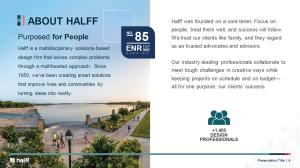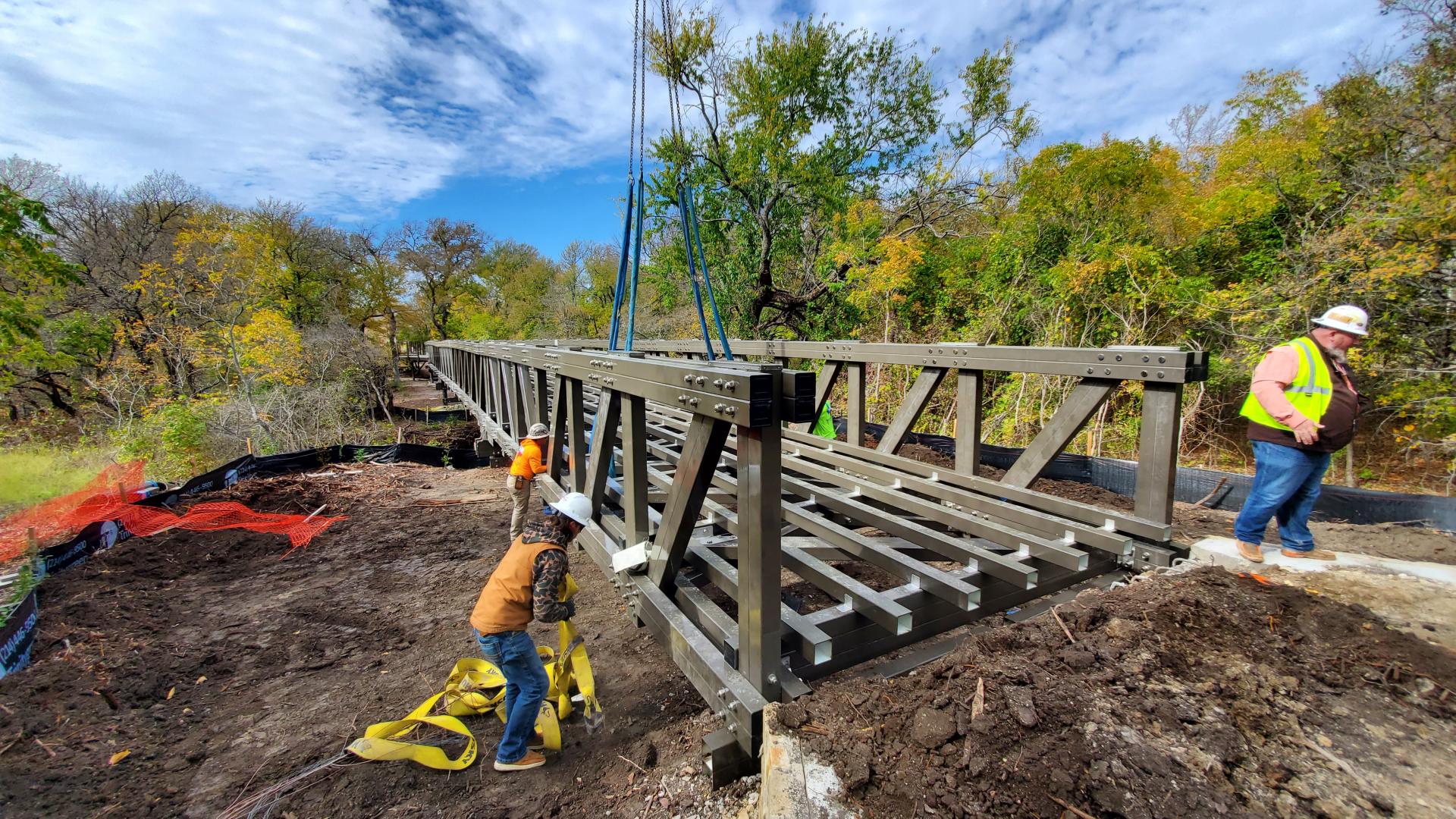Water surface elevation modelling on floodplains in Texas, USA was significantly reduced by constructing the City of Frisco’s new Dominion Trail pedestrian bridges out of Fibre Reinforced Polymer (FRP) structural profiles instead of traditional building materials.
Texan landscape architects, Halff were engaged by the city to provide a 3.65 metre wide shared-use path that worked in with existing trail networks including three crossings; and they needed to limit the rise within the 100-year floodplain.
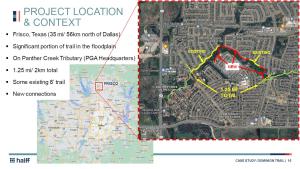
Project Manager, Justin Marston said they were facing an 45cm rise in water surface elevation using 610mm concrete piers for the segmented pedestrian bridges; which he said was unacceptable and they needed to come up with a better solution.
“We needed something that was strong, something that was durable, something that was lightweight, cost effective, something that looked good, was easy to work with and was able to reduce impact within the floodplain,” Justin Marston said.
“So that’s when we started looking more into Fibre Reinforced Polymer; and it started checking all of the boxes that we needed. It’s high strength, lightweight, looks good, has non-corrosive properties and a long lifespan; and we were actually looking at using FRP specifically for the boardwalk so there’d be good synergy between the boardwalk sections and bridges,” Mr Marston said.
“We talked to the manufacturer, Wagners Composite Fibre Technologies (CFT), and they were confident they could do spans up to 30-metres with FRP, so we started to work with them. And basically with the lighter weight material, we got significantly smaller piers from 127 – 228 mm and it was able to carry a vehicle,” he said.
“So we started running the hydraulic analysis and so when you go from 610mm to 228mm piers we saw a 62% reduction in the surface area of the piers within the floodplain. So now you’re going from 4.3 metres of blockage within the floodplain to 1.6 metres of blockage. So, when we ran these calculations and these hydraulic models, we only got a 127mm rise in the floodplain which was a 72% reduction to the water surface elevation comparing concrete piers to these 228mm FRP piers.”
“It was a huge difference and the increase was not going to affect any adjacent homeowners and this rise was still well within the flood areas and so the city was accepting of that design.”
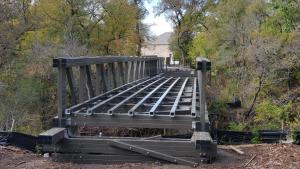
Picture – by using FRP Halff was able to achieve 30m spans and reduce impact to the floodplain.
Existing utilities also provided significant challenges to Halff in the design and construction of Dominion Trail.
“There was a 1220mm sanitary sewer pipeline and the site was surrounded by private property owners; with all the houses around this area and as much as people love their land here in Texas and they really wanted the trail, just not all of them wanted it next to their house, so we had to go through several different design phases to where we were looking for the best route for both feasibility as well as which property owners would be impacted,” Justin Marston said.
“We had to consider how these structures would affect the utilities. And if you put something over the utilities, would it have to be replaced if they needed to get in and work on the lines? How much equipment and what size of equipment would you need to bring in to make this possible?”
“Also keep in mind that a 54 metres steel bridge is about 68 tonne and you’ve got to have a pretty good amount of equipment to be able to bring that in, which again drives costs up on these projects,” Mr Marston said.
“We were able to use a smaller 12 metre bridge segment with the light weight FRP; that section of bridge could easily be unbolted, put off to the side, complete the utility work and then bolt in back into place,” he said.
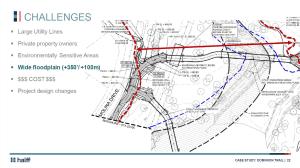
The lightweight nature of FRP also contributed to reducing costs on the project.
“Cost was obviously a big challenge on this project, just with the sheer amount of structures that we had and I know nobody’s ever had a project where they’ve started one way and said this is the approach, and then got into it and realised they’ve got to do something different; but we were able to adjust what we needed and work through it,” Justin Marston said.
“The original scope was to provide a trail at grade within the floodplain and to use more of a small low profile low water crossing design which we estimated would cost about $2.5 million (USD) at the 60% design submittal; which the city rejected after review requesting all structures be raised out of the floodplain,” Mr Marston said.
“They wanted to bring all the structures to 600mm above the 100-year floodplain; so that was a real game changer because we were talking about huge spans across the floodplain, some as large as 91 metres wide, a significant amount of elevated structures and bridge crossings which pushed our estimate to over $6.5 million (USD),” he said.
“But we regrouped, looked at the project needs from the utilities perspective and were able to modularise the structures to access them; considered the limitations of the floodplain and the impact to it from the structures and of course we really had to revisit the overall estimated costs to ensure we remained competitive.”
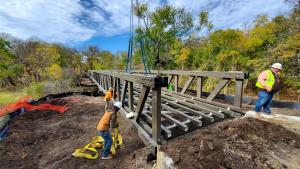
Picture – The lightweight nature of FRP also helped reduce overall project costs as Halff were able to use smaller equipment to get the job done.
The easiest solution may possibly have been a single span bridge over the entire floodplain; however, the cost exponentially increases with longer spans so Halff found a way to meet the client brief and reduce project costs by shortening the spans into smaller sections and utilising the lightweight and modular nature of FRP.
“The final construction cost with changes was $4.6 million (USA) and really like I said I think that’s testament to the knowledge and experience that we have building these trails and just looking at our history and learning every day. This whole project was an 18 month build from start to finish.”
The modular nature of FRP really came into its own during the construction phase of the project allowing Halff to minimise costs associated with installation.
“When you’re dealing with a steel bridge with the concrete decking, which is kind of our typical go to for most of these trail designs, when it’s all said and done, you’re looking at over 18 tonnes that you have to lift up and move. So, the fact that you’re only dealing with 6 tonnes for the same bridge constructed from FRP, it is really nice to be able to work with,” Justin Marston said.
“The smaller pieces and light weights mean you don’t require large and bulky equipment to push it around, so that contributes to reduced equipment costs, less wear and tear and increased safety for your teams on the ground too,” Mr Marston said.
“Having constructed the bridges from FRP, the largest piece we ended up having to lift in place was 8 tonnes and that was a 21 metre bridge,” he said.
“We pieced the 100-foot (30 metre) bridge together in different segments and this was a three day install for nine sections adding up to 500 feet (152 metres) in length. There was a one day install for the 100 foot bridge (30 metre) and then the rest of the bridges in two different sites was two days; but honestly I think we could have got it done in one day.”
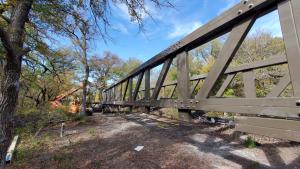
Picture – Halff were able to achieve less wear and tear on equipment and increased safety for teams on the ground through the use of FRP.
Frequency and deflection for FRP under American Association of State Highway and Transportation Officials (AASHTO) recommendations also posed some problems in design and construction of the Dominion Trail.
“Another big challenge and solution in the bridge design was compliance with AASHTO recommendations for frequency and deflection,” Justin Marston said.
“The frequency of the bridge or the bounciness of the bridge for FRP was 5 Hertz, and we were only able to get 4.2 and that was only for the 30 metre bridge, all of the other ones met or exceeded the 5 Hertz criteria,” Mr Marson said.
“But when it came down to it, there was nothing structurally wrong with the bridge; and the likelihood in this application of having 50-people at the same time walking in unison across the bridge was pretty slim; where a user might be able to feel more sway in the bridge than expected and feel slightly uncomfortable. After discussions with the city, the city was accepting of the design of the bridge and we proceeded with 4.2 Hertz and did not over engineer the bridge to meet the recommendation.”
“The next hurdle with AASHTO recommendations had to do with the deflection or bendiness of the bridge. There were some areas of the bridge where we were less than a 6mm over the maximum allowable tolerance that AASHTO recommends; but the decision was made that there was nothing structurally wrong with the bridge and cost effective versus some slight uncomfortableness in very rare circumstances was not worth changing,” he said.
There were many takeaways from the project, for the team from Halff who explained ‘there’s really no such thing as a bad idea’.
“Our key takeaways from the projects included looking at every challenge as though it were an opportunity that you can gain experience from; and bring all your ideas to the table,” Justin Marston said.
“Communication and talking to your clients…telling them ‘hey we’ve got this product that we think would be a great match and would solve a lot of problems that we’re dealing with on this project. If you don’t ask…the answer is always no.”
“Make sure you plan out the logistics of construction ensuring that you fully understand the sequence of how things need to be built; and be open and willing to learn all the time,” he said.
“Finally, know and really believe in what you are doing. For me, I truly believe I improve the lives of people in our community by connecting people to places and seeing a family ride their bikes all together on a trail that didn’t exist six months ago; and seeing that family be able to ride and enjoy nature is a really, really good feeling.”
“I met a gentleman out on the Dominion Trail and he was like ‘hey you know I can now ride to the grocery story that’s only half a mile away’; and so helping people make that connection between the natural and the built environments and being able to enhance those outside experiences is really something that drives us to do what we do…and we really enjoy that.”
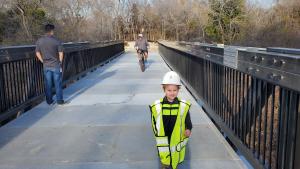
Picture – Landscape architect Justin Marston enjoys making positive impacts on communities through projects like Dominion Trail.
Since 1950, Halff has been improving lives and communities by turning ideas into reality.
“Halff is a multidisciplinary solution based design firm that solves complex problems through a multi faceted approach; we’ve been around for over 70 years and we’re really just a one stop shop,” Justin Marston said.
“We’re providing different services with different disciplines continuously collaborating with our clients to provide the best solutions for our users and ultimately the project and within the last 10 years, Halff has successfully designed over 70 trails totaling over 200 miles (321 kilometres),” Mr Marston said.
“And it’s fascinating to see all the different trails that we’ve created within that time.”
“One of the quotes that I really enjoy by some guy named Ralph Waldo Emerson is ‘do not go where the path leads, but go instead where there is no path and leave a trail’; and that’s exactly what we do with as much space that Texas has,” he said.
To watch the full YouTube webinar on the Dominion Trail bridge featuring guest speaker Justin Marston from Half visit https://youtu.be/8xByJJiBBv4
Discover more about Halff by visiting https://halff.com/
Or get in contact with Justin Marston via LinkedIn https://www.linkedin.com/in/justin-marston-pla-865ab52b0/
